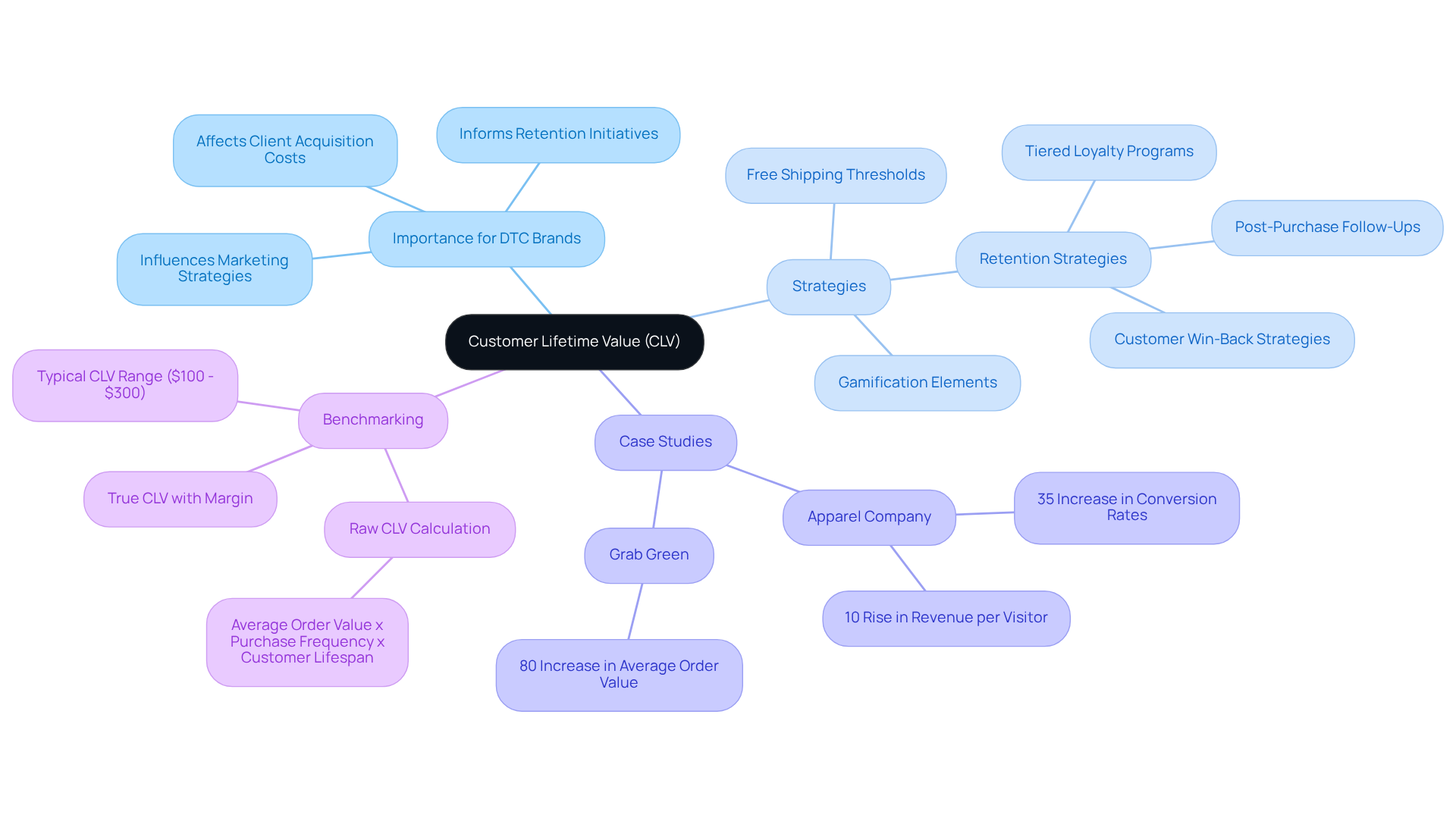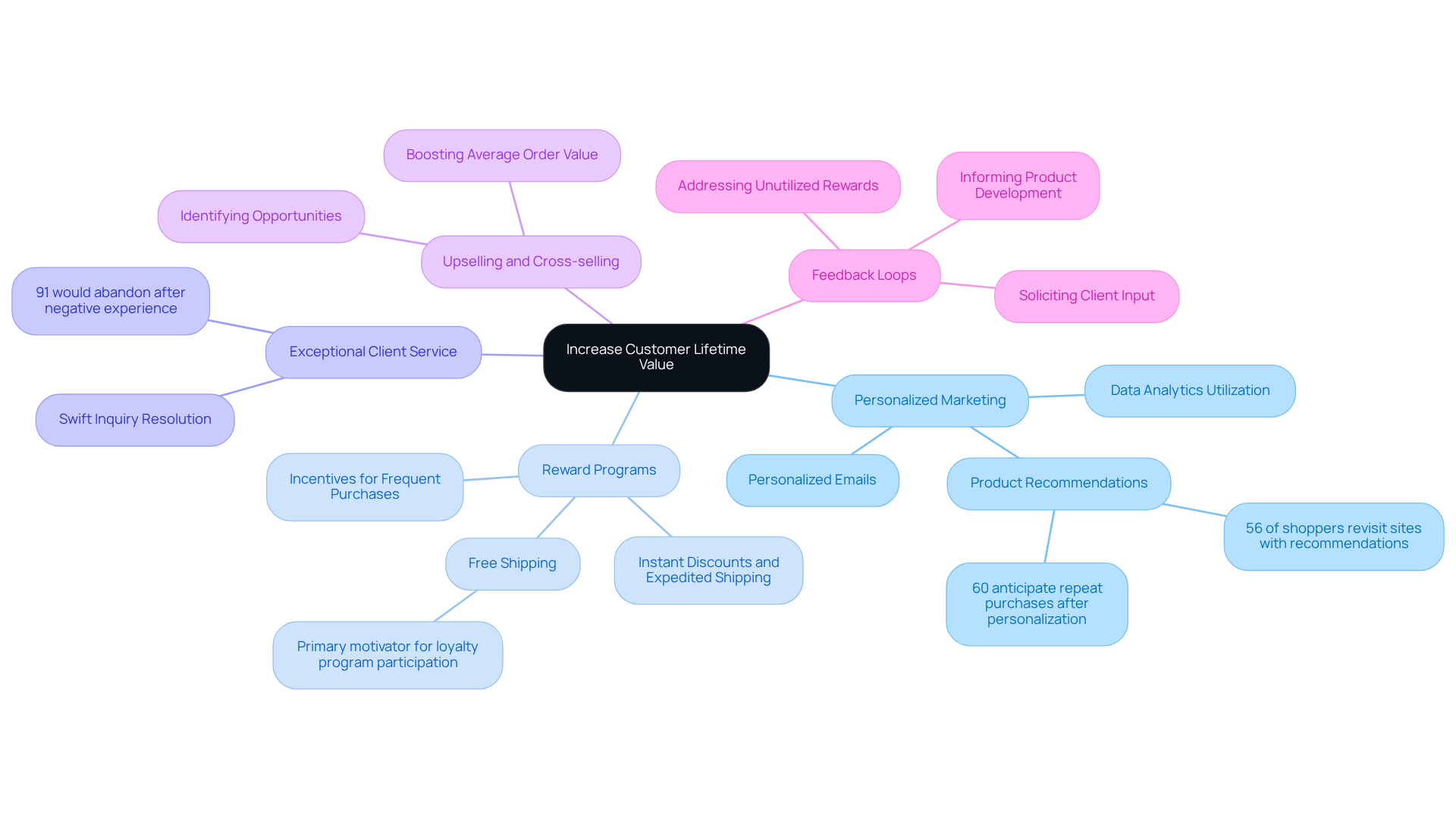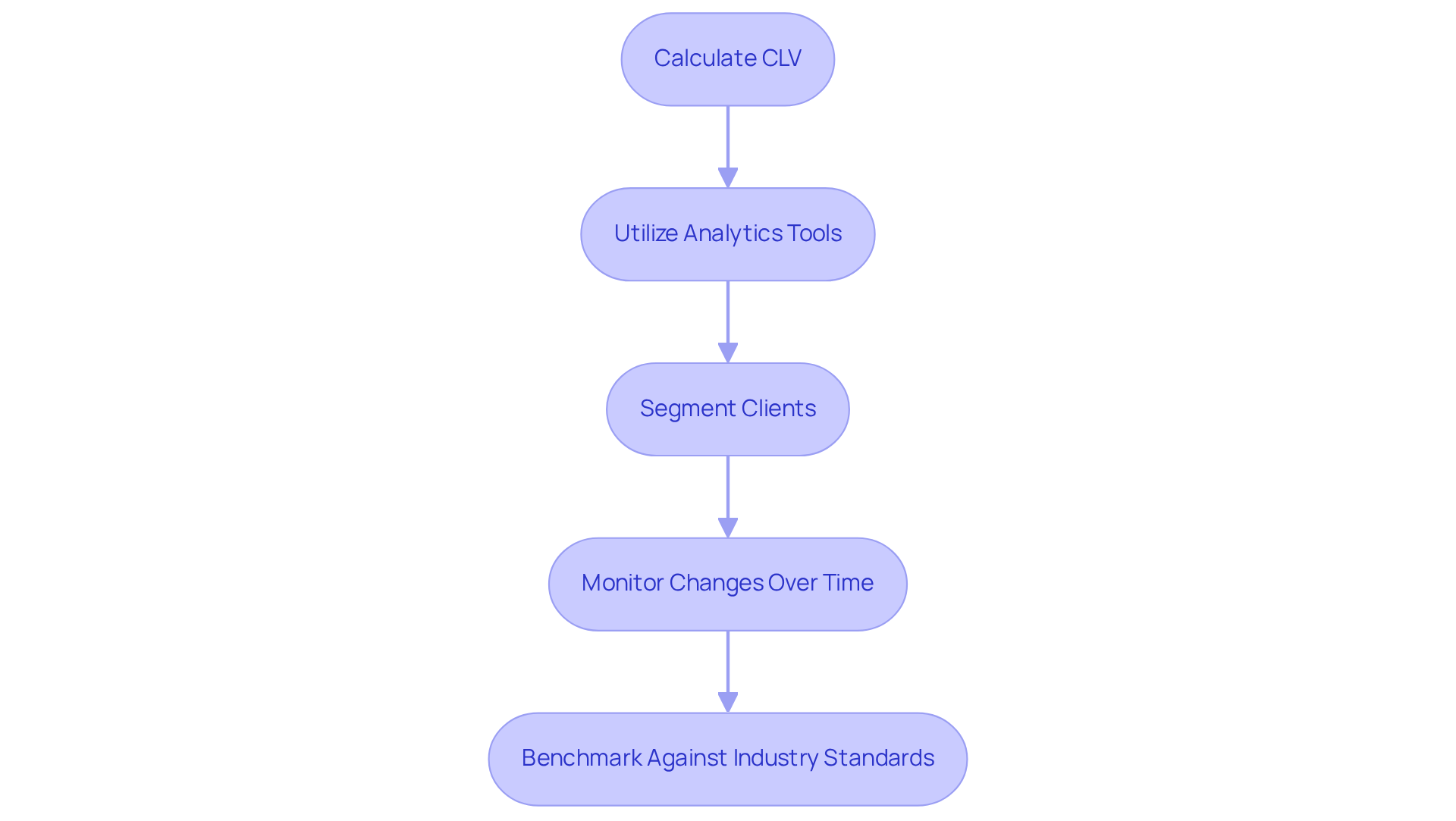
Overview
Customer Lifetime Value (CLV) is essential for direct-to-consumer (DTC) brands, as it estimates the total revenue expected from a customer throughout their relationship. This metric not only guides marketing strategies but also informs retention efforts. Enhancing CLV through personalized marketing, reward programs, and exceptional client service results in increased customer loyalty and profitability. Case studies illustrate significant improvements in conversion rates and average order values, underscoring the importance of these strategies.
Incorporating personalized marketing initiatives, brands can effectively engage customers, thereby fostering a deeper connection. Reward programs serve as an incentive, encouraging repeat purchases, which directly contributes to a higher CLV. Furthermore, exceptional client service enhances the overall customer experience, leading to stronger brand loyalty.
As evidenced by numerous case studies, the implementation of these strategies has led to tangible results. Brands that prioritize CLV not only see improved conversion rates but also experience an increase in average order values. The data clearly indicates that investing in CLV strategies is not just beneficial but essential for sustained growth in the competitive DTC landscape.
In conclusion, DTC brands must recognize the pivotal role of CLV in shaping their marketing and retention strategies. By focusing on personalized experiences, reward programs, and superior client service, brands can enhance customer loyalty and drive profitability.
Introduction
Understanding the intricacies of Customer Lifetime Value (CLV) is not just beneficial; it is essential for direct-to-consumer (DTC) brands striving for sustained success in an increasingly competitive marketplace. By prioritizing CLV, these brands can significantly enhance their marketing strategies and unlock the potential for increased profitability through improved customer retention and engagement.
However, the challenge lies in effectively implementing strategies that resonate with consumers and foster loyalty. Thus, how can DTC brands navigate this complex landscape to ensure that each customer relationship becomes a valuable asset?
Define Customer Lifetime Value and Its Importance for DTC Brands
Customer Lifetime Value (CLV) serves as a pivotal metric, estimating the total revenue a business can anticipate from a client throughout their relationship. For direct-to-consumer (DTC) companies, understanding customer lifetime value marketing is essential; it shapes marketing strategies, influences client acquisition costs, and informs retention initiatives. A higher CLV not only signifies that clients engage in repeat purchases but also suggests they are likely to refer others, thereby amplifying growth potential.
Focusing on CLV enables companies to devise retention strategies that prioritize long-term profitability over fleeting gains. For instance, a $30M apparel company collaborated with Parah Group to enhance its conversion rates. By redesigning their homepage to emphasize social proof and reviews, optimizing product pricing, and incorporating gamified elements, they achieved a remarkable 35% increase in conversion rates and a 10% rise in revenue per visitor. Such strategies not only bolster immediate sales but also contribute to customer lifetime value marketing, as clients become more inclined to return.
Similarly, Grab Green, a $15M cleaning product brand, encountered challenges with low average order values (AOVs). By testing free shipping thresholds and introducing bundles to incentivize larger purchases, they experienced an impressive 80% increase in AOV. This underscores how effective customer lifetime value marketing strategies can enhance client retention and ultimately elevate customer lifetime value.
Implementing reward programs can also have a significant impact on customer lifetime value marketing. Research indicates that even a modest 5% increase in client retention can boost profits by 25-95% in subscription models, highlighting the importance of nurturing existing client relationships. Parah Group's case studies illustrate that companies investing in tiered loyalty programs, which reward high-value clients and motivate others to increase spending, can witness substantial improvements in customer lifetime value marketing.
The typical CLV for eCommerce shops ranges from $100 to $300, providing a benchmark for DTC companies to assess their performance against industry standards. By concentrating on customer lifetime value marketing through innovative retention and marketing strategies, DTC companies can transform client relationships into sustainable revenue streams.

Implement Strategies to Increase Customer Lifetime Value
To effectively increase Customer Lifetime Value (CLV), DTC brands must implement robust strategies:
-
Personalized Marketing: Leveraging data analytics to categorize clients and tailor marketing messages according to their preferences and behaviors is essential. Personalized emails and product suggestions significantly enhance engagement; research shows that 56% of online shoppers are more inclined to revisit sites that offer such recommendations. Moreover, 60% of consumers anticipate becoming repeat purchasers following personalized shopping experiences, underscoring the critical role of personalization in fostering commitment.
-
Reward Programs: Establishing reward programs that incentivize frequent purchases is vital. By offering points, discounts, or exclusive access to new products, brands can effectively encourage consumer return. Notably, free shipping emerges as the primary motivator for consumers participating in loyalty programs, while instant discounts and expedited shipping also serve as significant incentives that enhance program effectiveness.
-
Exceptional Client Service: Delivering outstanding client service directly correlates with increased satisfaction and retention rates. Brands must ensure that client inquiries are addressed swiftly and efficiently; 91% of shoppers indicate they would abandon an online retailer after a negative shopping experience. This statistic highlights the imperative of prioritizing client support to maintain loyalty.
-
Upselling and Cross-selling: Empowering sales teams to identify upselling and cross-selling opportunities during client interactions is crucial. This approach not only boosts average order value but also enriches the overall client experience, fostering dedication.
-
Feedback Loops: Regularly soliciting input from clients is essential to understanding their needs and preferences. Such insights can inform product development and marketing strategies, ensuring offerings remain relevant and appealing. Brands that prioritize personalization and adapt to consumer feedback are better positioned to enhance customer lifetime value marketing and cultivate lasting relationships. Furthermore, addressing the issue of unutilized rewards in loyalty programs is critical, as these represent missed opportunities for both patrons and enterprises.

Measure and Analyze Customer Lifetime Value Effectively
To effectively measure and analyze Customer Lifetime Value (CLV), DTC brands must adopt a strategic approach that encompasses several key steps:
-
Calculate CLV: Start with the foundational formula CLV = (Average Purchase Value) x (Average Purchase Frequency) x (Customer Lifespan). This calculation provides a clear understanding of the value each client contributes to the business, laying the groundwork for informed decision-making.
-
Utilize Analytics Tools: Leverage powerful analytics platforms such as Google Analytics, Glew.io, and Lifetimely to monitor client behavior and purchasing trends. These tools deliver valuable insights into client journeys, empowering brands to refine their marketing strategies effectively.
-
Segment Clients: Conduct a thorough examination of CLV across different client segments, utilizing purchase history and RFM analysis. Identifying the most profitable groups through this segmentation allows for customer lifetime value marketing and optimized resource allocation.
-
Monitor Changes Over Time: Regularly evaluate CLV metrics to uncover trends and shifts in client behavior. Ongoing analysis is crucial for adjusting strategies, ensuring that brands consistently maximize CLV. It is vital to avoid using overly short timeframes when measuring CLV, as this can undervalue long-term clients.
-
Benchmark Against Industry Standards: Compare CLV metrics with industry benchmarks to assess performance. Understanding a company's position relative to competitors can reveal opportunities for enhancement and growth. Notably, increasing client retention by just 5% can lead to profit increases of 25-95%, underscoring the importance of monitoring these metrics.

Leverage Consumer Psychology to Enhance Customer Lifetime Value
To effectively leverage consumer psychology in enhancing Customer Lifetime Value (CLV), DTC brands must adopt key strategies that resonate with their audience:
-
Build Trust: Establishing trust is paramount for retaining clients. Brands can foster trust through transparent communication, consistent quality assurance, and dependable client experiences. A positive service experience significantly influences loyalty; indeed, 80% of Americans prioritize speed, convenience, and knowledgeable assistance. Furthermore, 81% of consumers express a desire to form a relationship with brands, underscoring the critical role of trust in retention strategies.
-
Create Emotional Connections: Storytelling in marketing initiatives effectively establishes emotional ties with clients. Brands that resonate on an emotional level are more likely to foster loyalty and encourage repeat purchases. Research indicates that 60% of consumers are more inclined to become repeat purchasers after a personalized shopping experience, highlighting the power of emotional engagement.
-
Utilize Scarcity and Urgency: Implementing marketing tactics that evoke a sense of scarcity or urgency—such as limited-time offers or exclusive products—can prompt quicker purchasing decisions. This strategy taps into consumer psychology, driving immediate action and enhancing sales.
-
Reward Loyalty: Acknowledging and rewarding devoted clients through personalized offers or exclusive access to new products not only enhances satisfaction but also promotes repeat business. Loyalty programs that offer tiered rewards significantly enhance customer lifetime value marketing and client retention, making individuals feel valued and appreciated. For instance, a meal plan service that offered subscription options experienced increased patron commitment and stable sales, showcasing the effectiveness of reward programs.
-
Foster Community: Creating a sense of community around the product through social media interaction and user forums can enhance loyalty. Brands that establish a community atmosphere enable patrons to engage with one another and the brand, resulting in customer lifetime value marketing as individuals experience a stronger bond and dedication to the brand. Interacting with clients in this manner converts transactional connections into enduring ones, ultimately fostering sustained growth. As noted, "A happy customer is a returning customer," emphasizing the critical role of customer satisfaction in loyalty.

Conclusion
Understanding and enhancing Customer Lifetime Value (CLV) is paramount for the success of direct-to-consumer (DTC) brands. By prioritizing CLV, companies can formulate impactful marketing strategies that emphasize long-term customer relationships over fleeting short-term gains. This strategic focus not only cultivates loyalty but also stimulates repeat purchases and referrals, ultimately propelling sustainable growth.
The article delineates a range of strategies to amplify CLV, including:
- Personalized marketing
- The implementation of reward programs
- The delivery of exceptional customer service
Furthermore, it underscores the critical role of analytics tools in measuring and analyzing CLV effectively, enabling brands to make informed decisions grounded in customer behavior. Engaging consumers through emotional connections and community-building further enriches loyalty, ensuring that customers feel valued and appreciated.
Incorporating these insights into marketing strategies is essential for DTC brands striving to excel in a competitive landscape. By emphasizing customer relationships and leveraging effective CLV strategies, brands can revolutionize their marketing approach, leading to enhanced profitability and enduring success. Embracing the principles articulated in this article empowers brands to not only deepen their understanding of customers but also to cultivate lasting connections that drive sustained growth.
Frequently Asked Questions
What is Customer Lifetime Value (CLV)?
Customer Lifetime Value (CLV) is a metric that estimates the total revenue a business can expect from a customer throughout their relationship with the company.
Why is CLV important for direct-to-consumer (DTC) brands?
CLV is essential for DTC brands as it shapes marketing strategies, influences client acquisition costs, and informs retention initiatives. A higher CLV indicates that customers are likely to make repeat purchases and refer others, enhancing growth potential.
How can focusing on CLV benefit a company?
Focusing on CLV allows companies to develop retention strategies that prioritize long-term profitability over short-term gains. This can lead to improved conversion rates and increased revenue per visitor.
Can you provide an example of a company that improved its CLV through marketing strategies?
A $30M apparel company worked with Parah Group to redesign its homepage, emphasizing social proof and reviews, optimizing product pricing, and adding gamified elements, resulting in a 35% increase in conversion rates and a 10% rise in revenue per visitor.
What challenges did Grab Green face, and how did they address them?
Grab Green, a $15M cleaning product brand, struggled with low average order values (AOVs). They tested free shipping thresholds and introduced bundles, leading to an 80% increase in AOV, demonstrating the effectiveness of customer lifetime value marketing strategies.
How do reward programs impact customer lifetime value?
Reward programs can significantly enhance customer lifetime value. Research shows that a 5% increase in client retention can boost profits by 25-95% in subscription models. Companies that invest in tiered loyalty programs can see substantial improvements in CLV.
What is the typical range of CLV for eCommerce shops?
The typical CLV for eCommerce shops ranges from $100 to $300, serving as a benchmark for DTC companies to evaluate their performance against industry standards.
How can DTC companies improve their customer lifetime value?
DTC companies can improve CLV by concentrating on customer lifetime value marketing through innovative retention strategies, optimizing marketing efforts, and nurturing existing client relationships to transform them into sustainable revenue streams.
FAQs











